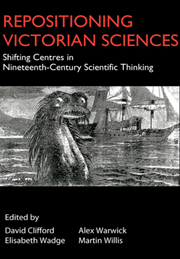Book contents
- Frontmatter
- Contents
- Notes on Contributors
- 1 Margins and Centres
- SECTION I Shifted Centres
- SECTION II Contested Knowledges
- 7 ‘Supposed Differences’: Lydia Becker and Victorian Women's Participation in the BAAS
- 8 A Fair Trial for Spiritualism?: Fighting Dirty in the Pall Mall Gazette
- 9 ‘This is Ours and For Us’: The Mechanic's Magazine and Low Scientific Culture in Regency London
- 10 How did the Conservation of Energy Become ‘The Highest Law in All Science’?
- 11 ‘Scriptural Geology’, Vestiges of the Natural History of Creation and Contested Authority in Nineteenth-Century British Science
- 12 ‘This House is a Temple of Research’: Country-House Centres for Late Victorian Science
- SECTION III Entering The Modern
- Notes
- Select Bibliography
11 - ‘Scriptural Geology’, Vestiges of the Natural History of Creation and Contested Authority in Nineteenth-Century British Science
from SECTION II - Contested Knowledges
Published online by Cambridge University Press: 05 March 2012
- Frontmatter
- Contents
- Notes on Contributors
- 1 Margins and Centres
- SECTION I Shifted Centres
- SECTION II Contested Knowledges
- 7 ‘Supposed Differences’: Lydia Becker and Victorian Women's Participation in the BAAS
- 8 A Fair Trial for Spiritualism?: Fighting Dirty in the Pall Mall Gazette
- 9 ‘This is Ours and For Us’: The Mechanic's Magazine and Low Scientific Culture in Regency London
- 10 How did the Conservation of Energy Become ‘The Highest Law in All Science’?
- 11 ‘Scriptural Geology’, Vestiges of the Natural History of Creation and Contested Authority in Nineteenth-Century British Science
- 12 ‘This House is a Temple of Research’: Country-House Centres for Late Victorian Science
- SECTION III Entering The Modern
- Notes
- Select Bibliography
Summary
The past two hundred years have seen naturalistic and often materialistic modes of scientific inquiry (as advocated by, for example, John Tyndall and Richard Dawkins) superseding the teleological and theistic methods used by earlier non-specialists. This hardening of the scientific viewpoint (though not absolute, particularly in physics) is interesting when one considers the concomitant increase in the acceptability to the general public of evolutionary explanations, the increase in the popularization of what was seen as ‘good science’, and the parallel reduction of extra-epistemic factors in evolutionary theorizing. In this essay I briefly examine two episodes within the development of a professional Victorian geology: the rejection of ‘scriptural geology’ by the emerging geological community and the controversy over the 1844 publication of Vestiges of the Natural History of Creation. Both of these episodes nicely illustrate the boundary work that went into delineating the emerging community from those that used, and what would become, sidelined modes of discourse. As a part of this delineation – and over the course of the early part of the century – geology was characterized as a practical, specialized, active, ‘masculine’ endeavour that was amenable to Christianity. Such rhetoric allowed the community to distance themselves from both Biblical literalists and the amateurs who in many ways founded the field, thus moving the adjudication of scientific claims out of the public sphere into the hands of what would eventually become the scientific profession.
- Type
- Chapter
- Information
- Repositioning Victorian SciencesShifting Centres in Nineteenth-Century Thinking, pp. 131 - 142Publisher: Anthem PressPrint publication year: 2006
- 2
- Cited by

